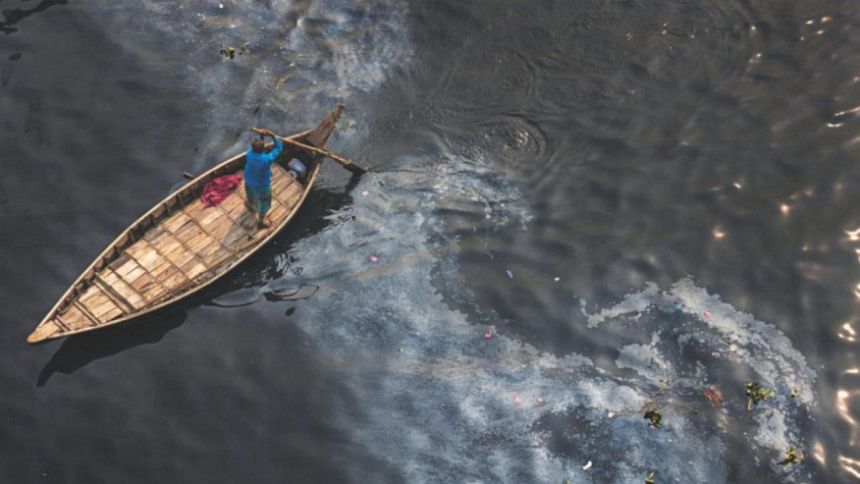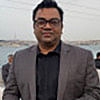A river runs through it

I have seen it on TV, read about it in newspapers, but never thought it would be this bad. I watched it from the deck of a launch, looking forward to a spectacular river cruise that our departmental picnic poster promised. I have fond memories of going back to my ancestral home in paddle steamers or launches while watching locals bathing or children frolicking in water; while food was being washed in water procured from the river. The putrid stench and the thick pollutants offered me a different plot. Much water has flowed under the bridge—literally. The Buriganga now sits idly by a thriving city that has lost interest in its partner. The translation that we once memorised while solving test papers, "Dhaka sits on the Buriganga", is lost. Instead, the tag of "most polluted river in the world" is gained, I look and ponder.
"Eventually the watcher joined the river, and there was only one of us. I believe it was the river." I wish I could write like Norman Maclean who felt that kind of "oneness" while watching fly-fishing in Blackfoot River in Montana in his semi-autobiographical novel A River Runs through It. I don't think any Dhakaite would anymore share similar connection with the Buriganga, upon which the city was once built. The Mughals liked it, allowing Dhaka to grow. Yet again, the filth that colonises the river starts to colonise my mind—and Buriganga and I were one.
I gazed at the Buriganga the way a murderer looks at its victim. The river that gave us life is now dead. We have returned its favour by killing it. We have sipped life out of the river that used to be the major source of our drinking water. The might with which the river once stretched and furrowed while rubbing and scouring, gnawing and kneading, devouring and carrying its ways through the city is tamed. It now stands still like a disgraced fallen hero who has been tainted with tar pit before execution. Small boats ferry across the river to connect the victors of this side with those from the other one; thousands of vehicles cross the bridges that fly over the dead victim that lies like a dirty dead python.
Everyday more than 1.5 million cubic metres of industrial and human waste reach the Buriganga and its adjacent rivers and tributaries. Of which, according to the Department of Environment, the daily contribution of the tanneries to the Buriganga is 21,600 cubic metres (5.7 million US gallons) of toxic waste. Add to that the amount of solid waste—4,500 tons per day deposited by the city dwellers. We can blame the tanneries, boatyards and shipyards, chemical dumping from industries, medical waste from hospitals, maritime transportation, city sewage, dead animals, or plastic bags as much as we want, but at the end of the day, it is our collective indifference that has killed the river. The river is lifeless—there is no oxygen left in it to keep its fish or aquatic lives alive. Even a ritualistic immersion of goddess cannot resuscitate life in a river that has morphed in a stagnant lake. The neons at the bank and the lights of the boat can hide the ugliness of the river at night with their artificial makeover, but the day breaks with bad news.
Four million people, who reside by this 18km river, live under serious threats of being contaminated by the toxic and polluted waters. Thanks to the daily dumping, the average depth of the river is only 7.6m, which makes the plying of larger vessels quite dangerous especially in dry seasons. The need for dredging is equally felt during monsoon seasons when our drainage system collapses resulting in citywide waterlogs. The famous axiom twists and turns as our failure to go and see the river makes the river come to our feet. Even a posh area such as Dhanmondi gets a taste of the Buriganga near the Rapa Plaza.
Jokes apart, the name of the river Buriganga has the distant memory of being connected with the great Ganges which becomes Padma upon entering our national territory. There was a time when this branch of Ganges (hence old Ganges—Buriganga) reached the sea through Dhaleswari River. The course changed and shifted, and Buriganga remained connected with its origin only in name. The main water that flows into the river today comes from the Turag, which meets with the Dhaleswari at Munshiganj.
With the exponential rise of land price in Dhaka, the rivers around it have come under the greedy glances of land grabbers and water-body hoarders. They use every weapons in their arsenal to justify their presence by the water. They use poly tricks of politics, they use holy signs of holy sites, they use under the table exchanges to bring changes over the table to get hold of the rivers, while strangling them to death. Often government bulldozers will come amidst resistance, local politicians will cry for rehabilitation before dismantling of illegal structures, harsh words will be exchanged, new promises will be made—but the elastic reality will soon retract to its previous band to choke the rivers.
As we dream of solidifying our middle-income country status by 2024, leaving behind our LDC tag, is it too much to ask for a capital city that is liveable? The city has many problems. Saving its rivers is a prime one. One way to restore life in the city is by giving life back to its lifeline—the Buriganga.
Restoring a river is more than having beautiful walkways by the riverbanks or making it less dirty. We need to have a complete understanding of the ecological and social functions of a river. The filth with which we look at a river often clouds our judgement. We think of a river as a natural resource to profit from. Time has come to repair the way we look at the river, and appreciate its value as a fellow creature of our ecology. For this we need to bring in changes to our curricula so that our children grow up loving their surrounding; our young ones make informed decisions before joining a save-the-river campaign; and our policymakers prioritise the flow of a river over the bank FDRs in foreign banks they are saving for their posterity. The community members must become stakeholders in sharing the responsibilities of maintaining natural resources such as a river.
Restoring a river involves repairing of the waterways that can no longer perform the necessary ecological and social functions. The Buriganga today cannot help us mitigate floods, provide clean drinking water, offer essential nutrients and sediments to its banks, support fisheries and wildlife. All these damaged issues need our attention. Even in commercial terms, healthy rivers enhance property values and can become a hub for recreation. Not having the river repaired is a callousness that we can ill afford.
We do not have to look far to find instances of river restoration. Singapore has done it successfully, and their efforts can provide us with a template. It is about time we dig out the foul mud and bring in fresh water into the Bruriganga. It is about time we drain out filthy thoughts, and breathe in positive thoughts. That will give us the impetus to celebrate the 50 years of independence where the river runs through the city without being chartered.
Shamsad Mortuza is a Professor of English, University of Dhaka (now on leave). Currently, he is Pro-Vice-Chancellor of ULAB.
Email: [email protected]

 For all latest news, follow The Daily Star's Google News channel.
For all latest news, follow The Daily Star's Google News channel. 



Comments